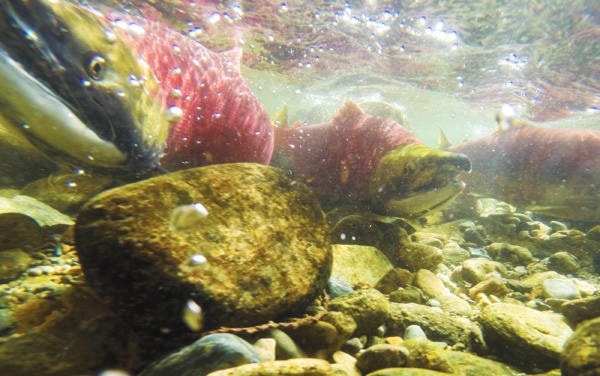The numbers prove what fisheries officials already knew in November – the late-run sockeye salmon return was lower than in 2014, the previous dominant year.
On the Lower Adams River, the spawning escapement dropped from 707,087 in 2014 to 535,564 in 2018.
The Lower Shuswap River escapement took a big hit, dropping from 832,810 in 2014 to 452,500 in 2018. On the Middle Shuswap, the drop was less dramatic – 194,780 in 2014 to 178,334 in 2018.
Spawning escapements were also lower on the Eagle River, dropping from 191,334 to in 2014 to 179,79 in 2018. The run from miscellaneous other locations dropped from 68,851 in 2014 to 43,711
The total late sockeye return to the Shuswap dropped from 2.2 million the 2014 dominant year to 1.5 million in 2018.
Related: Late run sockeye salmon numbers lower than 2014
“The estimates suggest that the mortality may have been a bit more than I was thinking in-season,” says Pacific Salmon Commission chief biologist Mike Lapointe. Fewer fish came up the Fraser River than the survey indicated, says Lapointe, noting late September surveys were indicating somewhere between 500,000 and one million and ended up at about 300,000 fish.
“We didn’t have the fish come out of the gulf and head upstream that we thought we would but we’re not sure why. Was there mortality or did the troller over-count?”
The 2018 estimates of fish reaching their spawning grounds was 76 per cent of the larger escapement in the 2014 parent year and Lapointe said it looks like 4.2 million late-run sockeye arrived to the Coast from their ocean homes in 2018 as opposed to 2014 when almost 9.6 million fish returned.
Related: VIDEO: Close to 6 million late-run sockeye heading for Shuswap
“That meant many fewer fish available to make it to the spawning areas,” Lapointe says, noting there can be huge variations in the rates of return. “The 2018 pre-season forecast was almost 7.4 million for late-run sockeye but there was a one-in-four chance the run could be as low as 4.8 million and that’s what we got.”
But Shuswap Environment Action (SEAS) president Jim Cooperman has another perspective.
He says the Watershed Watch Salmon Society has crunched all the information provided by the three responsible management agencies (Pacific Salmon Commission, Fraser River Panel and Fisheries Canada) into a spreadsheet that shows the “details missing from the government’s report.”
“While the pre-season expectation was 7.4-million, the majority of the fishing decisions were based on a 6-million run estimate, which was scaled back to the final estimate of 4.7-million after fishing was concluded,” he says. “The final total return was only 4.35-million of which nearly 2.7-million fish ended up in the fishing boats.”
Related: Race is on for Shuswap late-run sockeye salmon
Cooperman maintains management of the run is dictated by a goal of maximizing the harvest while playing lip-service to the sustainability of the population, despite the recognition that the all of the late run conservation units are listed with the Committee on the Status of Endangered Wildlife in Canada as either ‘endangered,’ ‘threatened’ or of ‘special concern,’ he says.
“This year the panel, which is largely made up of harvesting interests and U.S. and Canadian government representatives, exceeded their planned ‘allowable exploitation rate’ of over 58 percent on late-run sockeye, with a final rate of 63 percent,” he says. “Consequently, only 1,58 million late-run sockeye returned to spawn, which was just 63 percent of the dominant cycle average. It was only luck, not good management that the harvest was not greater and the damage to the population more severe, as they were prepared to catch 3.5-million sockeye if they had been able to find the numbers.”
Lapointe meanwhile, points out that forecasts are usually based on the number of spawners that head to the ocean and while the range seems broad, it is a reflection of the huge natural fluctuation in run sizes that scientists don’t understand.
@SalmonArm
barb.brouwer@saobserver.net
Like us on Facebook and follow us on Twitter
